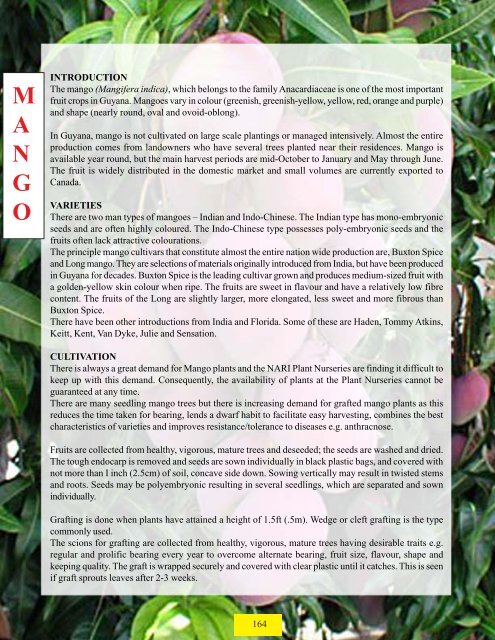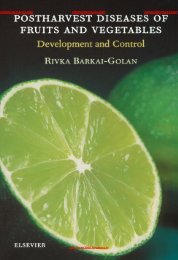M A N G O
Mangoes - Guyana Marketing Corporation
Mangoes - Guyana Marketing Corporation
- No tags were found...
Create successful ePaper yourself
Turn your PDF publications into a flip-book with our unique Google optimized e-Paper software.
M<br />
A<br />
N<br />
G<br />
O<br />
INTRODUCTION<br />
The mango (Mangifera indica), which belongs to the family Anacardiaceae is one of the most important<br />
fruit crops in Guyana. Mangoes vary in colour (greenish, greenish-yellow, yellow, red, orange and purple)<br />
and shape (nearly round, oval and ovoid-oblong).<br />
In Guyana, mango is not cultivated on large scale plantings or managed intensively. Almost the entire<br />
production comes from landowners who have several trees planted near their residences. Mango is<br />
available year round, but the main harvest periods are mid-October to January and May through June.<br />
The fruit is widely distributed in the domestic market and small volumes are currently exported to<br />
Canada.<br />
VARIETIES<br />
There are two man types of mangoes – Indian and Indo-Chinese. The Indian type has mono-embryonic<br />
seeds and are often highly coloured. The Indo-Chinese type possesses poly-embryonic seeds and the<br />
fruits often lack attractive colourations.<br />
The principle mango cultivars that constitute almost the entire nation wide production are, Buxton Spice<br />
and Long mango. They are selections of materials originally introduced from India, but have been produced<br />
in Guyana for decades. Buxton Spice is the leading cultivar grown and produces medium-sized fruit with<br />
a golden-yellow skin colour when ripe. The fruits are sweet in flavour and have a relatively low fibre<br />
content. The fruits of the Long are slightly larger, more elongated, less sweet and more fibrous than<br />
Buxton Spice.<br />
There have been other introductions from India and Florida. Some of these are Haden, Tommy Atkins,<br />
Keitt, Kent, Van Dyke, Julie and Sensation.<br />
CULTIVATION<br />
There is always a great demand for Mango plants and the NARI Plant Nurseries are finding it difficult to<br />
keep up with this demand. Consequently, the availability of plants at the Plant Nurseries cannot be<br />
guaranteed at any time.<br />
There are many seedling mango trees but there is increasing demand for grafted mango plants as this<br />
reduces the time taken for bearing, lends a dwarf habit to facilitate easy harvesting, combines the best<br />
characteristics of varieties and improves resistance/tolerance to diseases e.g. anthracnose.<br />
Fruits are collected from healthy, vigorous, mature trees and deseeded; the seeds are washed and dried.<br />
The tough endocarp is removed and seeds are sown individually in black plastic bags, and covered with<br />
not more than I inch (2.5cm) of soil, concave side down. Sowing vertically may result in twisted stems<br />
and roots. Seeds may be polyembryonic resulting in several seedlings, which are separated and sown<br />
individually.<br />
Grafting is done when plants have attained a height of 1.5ft (.5m). Wedge or cleft grafting is the type<br />
commonly used.<br />
The scions for grafting are collected from healthy, vigorous, mature trees having desirable traits e.g.<br />
regular and prolific bearing every year to overcome alternate bearing, fruit size, flavour, shape and<br />
keeping quality. The graft is wrapped securely and covered with clear plastic until it catches. This is seen<br />
if graft sprouts leaves after 2-3 weeks.<br />
164 164





